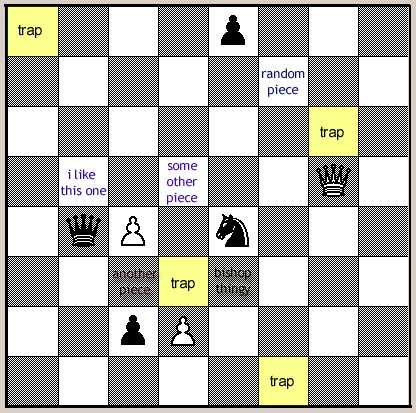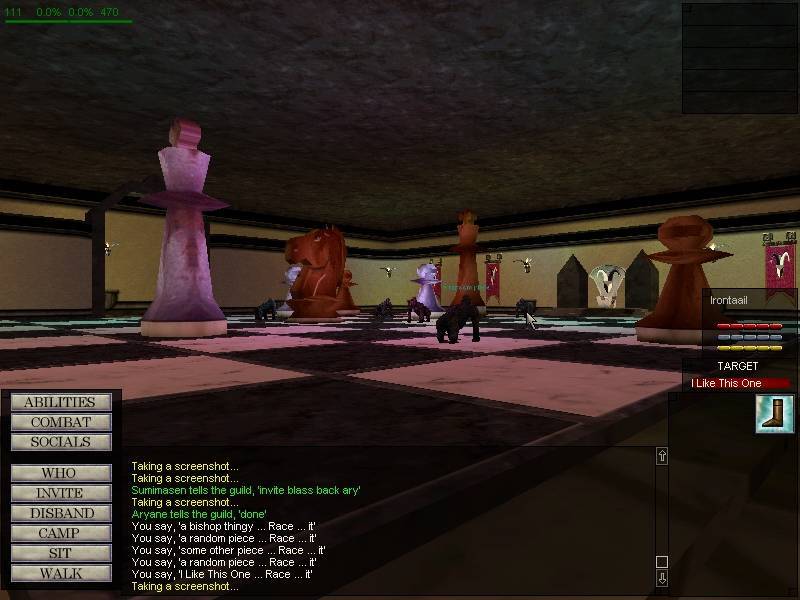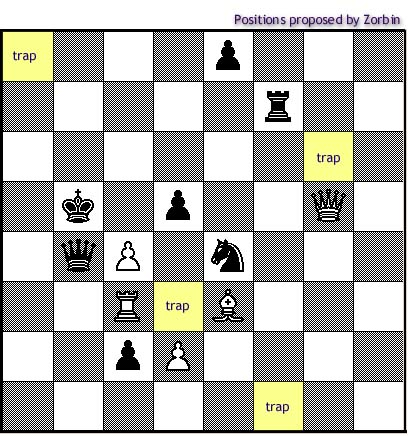Please note my Map is wrong ... WQ=White King and BQ=Black King .. 8-)




Zorbin's Chess Analysis:
First, it does appear to be a game in process.
Black just moved his knight to King5, declared check and now it's white's
turn. By all respects, it would appear black is bristlebane because you
are clearly white, and its your move.
The question is, what are all the gorillas?
So, lets start with the easy one, Bishop Thingy. Assuming this is a bishop, it HAS to be whites because otherwise it would have already put white in check. So, Bishop Thingy is whites, Bishop.
I Like This One. I am making an assumption here, but it's an educated one. The use of "I" would seem to mean that this is particularly liked by the person who set this up. This means it MUST be their piece. This also makes sense because almost any other piece of whites would either create check or be nearly impossible to get to that location. Taking a small, but I think reasonable, leap I believe this is the black queen, almost everyone's favorite piece.
Next lets look at Another Piece. We'll figure it out by elimination starting with Black. Pawn? Unlikely. In all likelihood if this was a black pawn it would have taken or been taken by the white pawn at Knight 5. Any other piece would have been most likely taken by that same pawn in the last move. So the odds are low it is a black unless it is protected, and even then, a trade makes more sense. So, it is most likely white. White options. Pawn? no, King in check. Knight? No, queen would have been taken a while ago. Bishop? Can't be, white bishop already on the board. Queen? No, King in check. Rook? Yes. It's a great location for the piece. Previous to the black knight move it was not threatened either and it is still protected by a pawn. This is the white rook. It also explains why black doesn't just take out the pawn threatening the queen.
Some Other Piece. This one is a bit trickier. Lets start with black. Pawn? Logical, safe location. no reason I can think of that it is not. Rook? Nope, puts king in check. Bishop? Could be but then the moving the knight was dumb. Take out the pawn threatening the queen instead. Unlikely. Knight? Again unlikely. Then the better move would have been to take out the unprotected bishop. So, if it's black, it's probably a pawn. White: Pawn? Possible, but unless this piece is protected by Random Piece, the best move would have been to take it with the queen, not move the knight. So, lets assume it's a black pawn unless random piece turns out to be a white queen. (can't be a white bishop because that's already on the board)
Random Piece. This is the hardest one of all. Lets start with White. It can't be anything of significance from white, or the move with the knight was silly, it would have been better to take this piece with the knight (his most likely previous position being Bishop4) or at minimum take it with the pawn. So, this piece is probably NOT a white piece. So lets look at the black piece options. Pawn? Possible, no reason for it not to be. Bishop? Possible, no reason for it not to be. Rook? Possible, No reason for it not to be. Knight. Can't be, king in check. So, it truly could be a number of things. I tried to look at why the knight was moved and what other options were there if these were different pieces and came up with this. Pawn? Moving the knight is not very useful move. Sure, it puts the king in check but he has lots of options of places to go. Moving the threaten queen would seem to be the smarter move. Bishop? Again, moving the knight doesn't do a lot for black position. Stepping the queen out first would seem to be smarter. In fact, moving the queen leads to an almost inevitable checkmate. So, Bishop is unlikely. Rook? Now it's a smart move. This starts a process that will probably lead to checkmate. My vote is, it's a rook.
It doesn't matter how it's done, in this scenario I can't find a way for white to avoid checkmate. Sometimes it takes a while and white can sacrifice some pieces to stay alive, but in the end, white dies.
So, what? I don't know. I don't know how this can apply to anything, but it was interesting to figure out. Maybe others can use this little analysis to help them out, I don't know. Or, maybe it's all a bunch of bull.
Enjoy!
